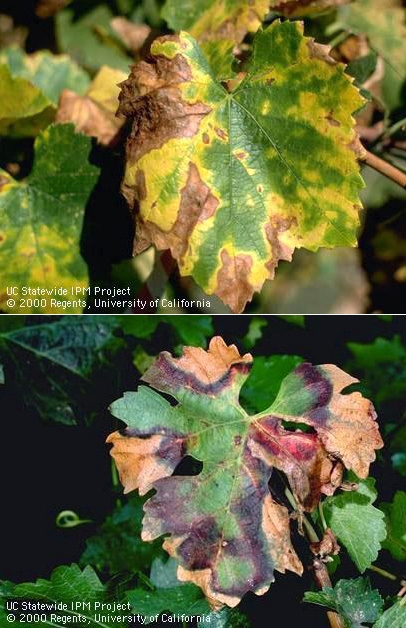It has been several years since Pierce’s disease (PD), the debilitating grapevine disease caused by the bacterium Xylella fastidiosa, has caused significant problems for San Joaquin Valley vineyards. PD dropped off the radar of valley grape industries and growers partly due to other invasive grape pests (vine mealybug, EGVM, etc.) inhabiting vineyards and to a low incidence of PD found throughout the valley. However, in recent months glassy-winged sharpshooter (GWSS) has been trapped in west Fresno County commercial vineyards and near the San Joaquin River. The recent catches are concerning since they have been found near a major riparian corridor that has had a historically low level of PD. With these recent GWSS catches, growers should survey their vineyards and test grapevines displaying PD-like symptoms in order to minimize potential “hot” spots from developing should GWSS become established.
|
Four PD symptoms to look for in late summer
|
Pierce's Disease Summer Symptoms
PD infected vines display several symptoms in late summer. Burned or scalded canopies are the first and easiest symptoms to spot. However, there are other diseases (measles), pests (mites), chemical maladies (sulfur burn) and/or cultural practices (poor irrigation management) that can cause foliage to burn. It is important to correctly determine the cause of any leaf burn symptoms that may be noticed. White varieties suffering from PD will display yellowing of the leaf margins followed by necrosis, while infected red varieties exhibit reddening prior to necrosis (see photo). Dead leaves on red or white grapes will detach from the petioles that dry and remain attached to canes, resembling matchsticks. Irregular wood maturity, a prominent symptom on canes, is marked by lignified wood surrounded by green tissue that never fully matures. Fruit from infected vines will shrivel, raisin and drop from the vine.
PD Insect Vectors
In the valley green and red-headed sharpshooters may vector PD, maintaining it at low levels. Those sharpshooters primarily feed on grasses, but as irrigated pastures, ditch banks and weed patches dry, they move into vineyards and feed on new succulent grapevine growth near shoot tips. Sharpshooters carrying PD will transmit the bacterium at the point of feeding but it rarely becomes a systemic infection; hence the low PD levels found in the San Joaquin Valley. Since its introduction, GWSS has changed the presence and spread of PD in CA. The voracious feeding of GWSS, it’s ability to feed on older, more lignified tissues, and its ability to fly longer distances makes it an exceptional vector of PD. Glassy-winged sharpshooters often feed near the base of shoots or on 2-year old wood increasing the chance for late-season infections. It also has a large host range that includes citrus, on which it breeds and may develop into very high populations. Many of the hosts that GWSS can survive and reproduce on have not been of concern with our grass feeding sharpshooters.
More information
Pierce’s Disease ANR Publication-21600 can be purchased at your local UC Cooperative Extension office or online at: http://anrcatalog.ucdavis.edu/
Attached Images:
